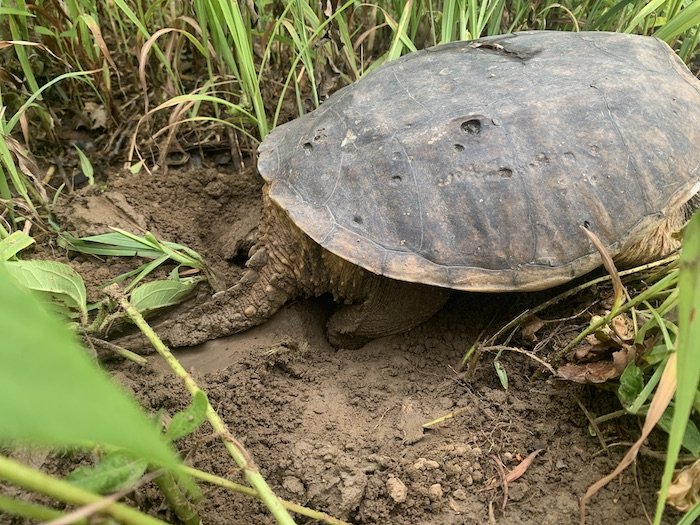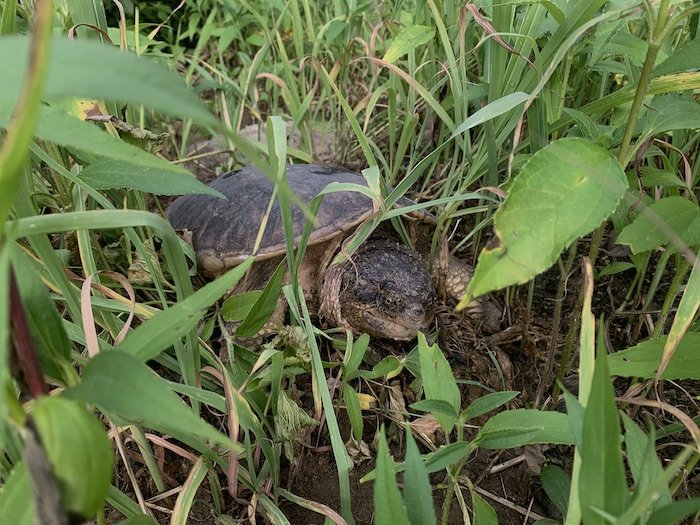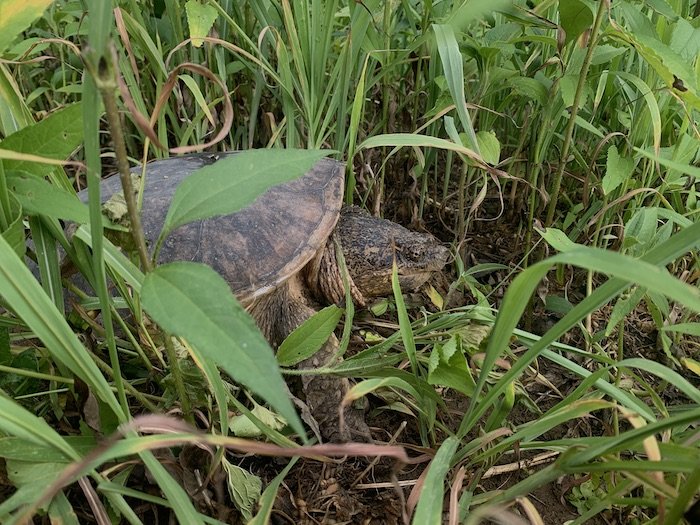What’s in Our Creek?
Hey there, Creation Explorer!
At our new home, there’s a creek that runs across our backyard. We love wandering up and down the creek, exploring God’s beautiful creation. And we’ve seen so many amazing creature friends!
Snapping Turtle
After a massive rainstorm that flooded our creek, Winston saw a little head peeping out from behind some grass. It was a snapping turtle!
The snapping turtle kind (Chelydridae) features the largest freshwater turtles in North America, snapping turtles and the much larger alligator snapping turtles. These turtles have long tails covered in really cool triangular crests.

Often these turtles are called “dinosaur-like” or “ancient.” In fact, they’re actually considered “living fossils,” basically unchanged over “90 million years” of supposed evolution. But this kind isn’t “ancient”—turtle kinds, including this one, were created by God during creation week just 6,000 years ago. And the reason this turtle hasn’t changed much from its fossil representatives is because it didn’t evolve over millions of years! This kind was created fully formed and functioning from the beginning.
Fun fact: Snapping turtles hibernate (sleep) during the winter at the bottom of lakes and ponds—in some places not taking a breath for six months.
Snapping turtles can live for over 100 years, and it often takes 15–20 years before they can reproduce. A female can lay up to 100 or so eggs, but fewer than 1 out of every 100 will survive to adulthood as eggs and baby turtles are a yummy snack for racoons, skunks, and other animals in our fallen world.
Whether baby snapping turtles will hatch as males or females depends on how warm their nest is. That’s different from how God created humans. Our genetics determine whether God has created us as a boy or girl right from the very moment of fertilization!
Stewardship tip: What should you do if you find a snapping turtle in a place it shouldn’t be, like the middle of the road? If you can do so safely and you have a parent’s assistance, help the turtle across the road using a shovel to gently move it or poke it along, or even throw a blanket over it and carefully pick it up. Snapping turtles can be aggressive if they feel unsafe (that’s why they’re called snapping turtles!) so don’t try to pick it up with your bare hands. Also, never grab a turtle by its tail as that can break its back or severely injure it!
Tadpole Puddle
Farther up the creek, we found a large puddle that seemed to be moving. It was filled with hundreds of tiny black tadpoles!
We think these tadpoles are the offspring of Fowler’s toads, a small toad native to much of eastern North America, including Northern Kentucky (we’ve found adults in our yard before). The tadpoles eat the algae and bacteria they scrape off of rocks and aquatic plants. But once they mature into adult frogs, they begin chowing down on insects and invertebrates such as snails and worms.
Fun fact: Ever smelled a Fowler’s toad? Their skin smells like unroasted peanuts.
When a frog or a toad hatches from an egg, it looks nothing like a frog or a toad! It has a long tail, gills for breathing underwater, a “beaked” mouth for scraping algae off rocks, and no long sticky tongue! Over the next number of weeks, that tadpole will metamorphize (change) into a frog/toad as legs pop out from the tadpole’s sides, the tail begins to shrink, and the gills disappear as lungs appear for breathing air. As the frog or toad grows from the tadpole, it “recycles” body parts (like the tail) to make new body parts!
All the information to turn a tadpole into a frog or toad was put into the DNA of the various toad and frog kinds. What a fascinating design from our Creator!
Rainbow Scarab Beetle
Now, we didn’t find this little creature friend in our creek—but she did come from the direction of the creek and landed on our porch. And she’s beautiful!

Fun fact: Rainbow scarabs have yellow antennae that can curl up into a ball under their heads.
This beetle is aptly named a rainbow scarab beetle due to her shimmering, glittering exoskeleton (beetles carry their skeleton outside them, rather than inside like we do). Scarab beetles are a type of dung beetle and are therefore really helpful to have around as they break down poop (gross!). Females, like the one we found (males have a big, curved horn), lay eggs under a pile of poop, forming some of that poop into “dung balls” stored in channels for the hatching larvae to eat. This helps recycle nutrients into the soil for plants to use again.
Well, we’re off on another adventure. Until next time, keep exploring God’s creation, remembering that it all gives God glory. “For his invisible attributes, namely, his eternal power and divine nature, have been clearly perceived, ever since the creation of the world, in the things that have been made” (Romans 1:20).
Bye!
- © 2025 Answers in Genesis
- Privacy Policy
- Contact
- About


